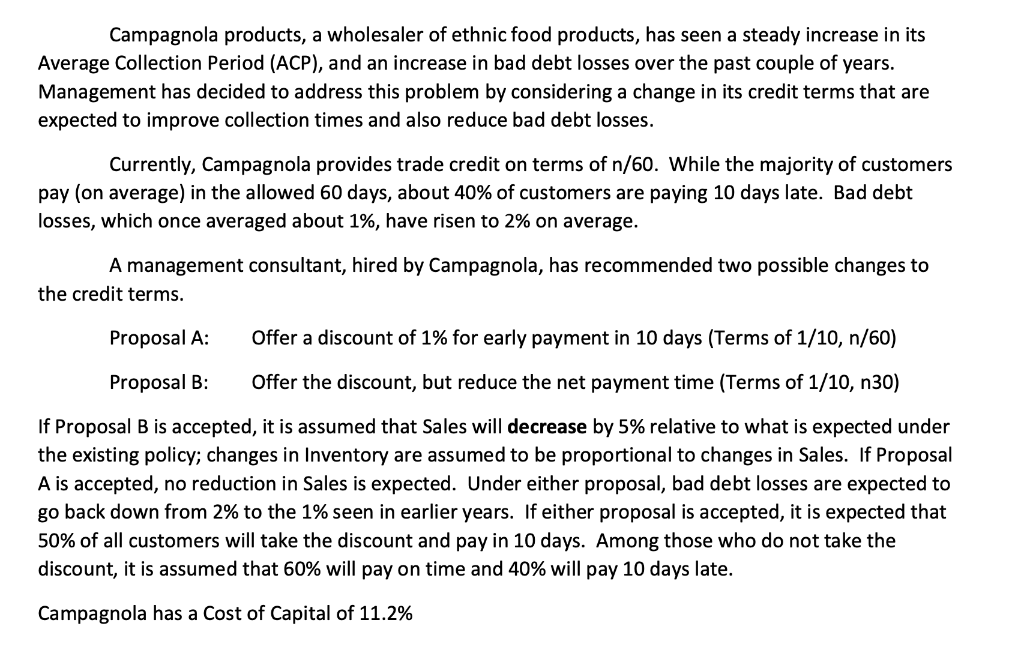What is the annualized effective cost of foregoing the discount under each proposal?
What is the net benefit of each proposal?


Campagnola products, a wholesaler of ethnic food products, has seen a steady increase in its Average Collection Period (ACP), and an increase in bad debt losses over the past couple of years. Management has decided to address this problem by considering a change in its credit terms that are expected to improve collection times and also reduce bad debt losses. Currently, Campagnola provides trade credit on terms of n/60. While the majority of customers pay (on average) in the allowed 60 days, about 40% of customers are paying 10 days late. Bad debt losses, which once averaged about 1%, have risen to 2% on average. A management consultant, hired by Campagnola, has recommended two possible changes to the credit terms. Proposal A: Offer a discount of 1% for early payment in 10 days (Terms of 1/10, n/60) Proposal B: Offer the discount, but reduce the net payment time (Terms of 1/10, n30) If Proposal B is accepted, it is assumed that Sales will decrease by 5% relative to what is expected under the existing policy; changes in Inventory are assumed to be proportional to changes in Sales. If Proposal A is accepted, no reduction in Sales is expected. Under either proposal, bad debt losses are expected to go back down from 2% to the 1% seen in earlier years. If either proposal is accepted, it is expected that 50% of all customers will take the discount and pay in 10 days. Among those who do not take the discount, it is assumed that 60% will pay on time and 40% will pay 10 days late. Campagnola has a cost of Capital of 11.2% Income Statement Sales $1,170,000 COGS $819,000 Gross Profit Fixed Expenses $351,000 $187,200 $163,800 EBIT Interest Expense $33,800 EBT $130,000 $45,500 Income Tax Net Income $84,500 Balance Sheet Cash $52,000 Accounts Payable $83,200 Accounts Receivable Notes Payable 156,000 Inventory 205,150 156,000 413,150 Total Current Liab. 239,200 Total Current LTD 208,000 Equity 485,950 Total Assets $933,150 Total L&E 933,150 Campagnola products, a wholesaler of ethnic food products, has seen a steady increase in its Average Collection Period (ACP), and an increase in bad debt losses over the past couple of years. Management has decided to address this problem by considering a change in its credit terms that are expected to improve collection times and also reduce bad debt losses. Currently, Campagnola provides trade credit on terms of n/60. While the majority of customers pay (on average) in the allowed 60 days, about 40% of customers are paying 10 days late. Bad debt losses, which once averaged about 1%, have risen to 2% on average. A management consultant, hired by Campagnola, has recommended two possible changes to the credit terms. Proposal A: Offer a discount of 1% for early payment in 10 days (Terms of 1/10, n/60) Proposal B: Offer the discount, but reduce the net payment time (Terms of 1/10, n30) If Proposal B is accepted, it is assumed that Sales will decrease by 5% relative to what is expected under the existing policy; changes in Inventory are assumed to be proportional to changes in Sales. If Proposal A is accepted, no reduction in Sales is expected. Under either proposal, bad debt losses are expected to go back down from 2% to the 1% seen in earlier years. If either proposal is accepted, it is expected that 50% of all customers will take the discount and pay in 10 days. Among those who do not take the discount, it is assumed that 60% will pay on time and 40% will pay 10 days late. Campagnola has a cost of Capital of 11.2% Income Statement Sales $1,170,000 COGS $819,000 Gross Profit Fixed Expenses $351,000 $187,200 $163,800 EBIT Interest Expense $33,800 EBT $130,000 $45,500 Income Tax Net Income $84,500 Balance Sheet Cash $52,000 Accounts Payable $83,200 Accounts Receivable Notes Payable 156,000 Inventory 205,150 156,000 413,150 Total Current Liab. 239,200 Total Current LTD 208,000 Equity 485,950 Total Assets $933,150 Total L&E 933,150








